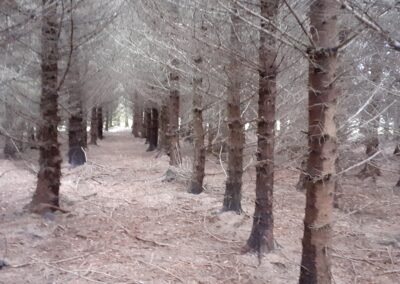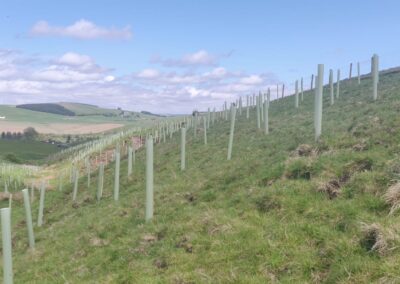Not all woodland creation needs to be large scale; small pockets of woodland creation across a farm holding can bring significant improvements to the landscape and its wildlife.
Symington Mains Farm approached Forest Direct Ltd to develop a 3.89 ha riparian and native broadleaf habitat across their holding, creating new forest habitat for the long-term, expanding and complementing the existing woodland for farm shelter and biodiversity enhancement. However, through the initial meetings, it became clear to both parties that this was not just about woodland creation but also about a need to manage the existing woodland that was coming to the end of its lifespan.
Objective
Our client was looking to strengthen and improve the riparian habitat zone, grow farm biodiversity and increase native woodland to complement existing woodland for farm shelter. In addition, they wanted to understand the condition of their existing woodland and create a management plan to ensure they could meet the farm’s long-term requirement for shelter.
Fast Facts
Client: Symington Mains Farm
Project developer: Forest Direct Ltd
Previous land use: Improved pasture
Area: Gross area: 3.89 Net area: 3.29 Open ground: 0.6
Woodland Creation:
Species Mix:
Native Broadleaves 85%
Open Ground 15%
Trees planted: Birch, alder, oak, aspen, willow, rowan
Woodland Management:
Minimum intervention of broadleaves for long-term habitat retention
Estimated net carbon Sequestration (tCO2): 1,327 tonnes
Woodland Carbon Code – Group scheme
Existing Woodlands:
Thinning – 400 tonnes
Woodland Management Plan produced
Approach
The owners approached Forest Direct Ltd for advice on managing their existing woodland shelterbelts planted 30 years ago. During the surveying phase, we worked with the owners to understand the importance of each block of existing woodland to the farm and its operations.
It was clear that some of the planted areas were essential for farm shelter but were coming to the end of their lifespan. As a result, Forest Direct developed management plans focused on thinning some of the existing woodlands now, with phased clear felling in the future to ensure the essential shelter was maintained for the long term. Planting new shelterbelts may also be considered to provide protection when the existing cover on the hill is felled.
The project included 1km of river habitat enhancement by planting a riparian native woodland zone adjacent to the farm’s main watercourse. This was planted with a diverse species mix of birch, alder, oak, aspen and willow, which will significantly improve the landscape, mitigate the risk of diffuse pollution, mitigate against flooding and support farm wildlife. 10% of the area was planted at an increased density to meet grant requirements and provide a future wood fuel resource for the farm.
Further pockets of native broadleaves were planted behind farm buildings and within an existing block of Sitka spruce to retain some long-term shelter after the conifer block is felled in 25 years.



